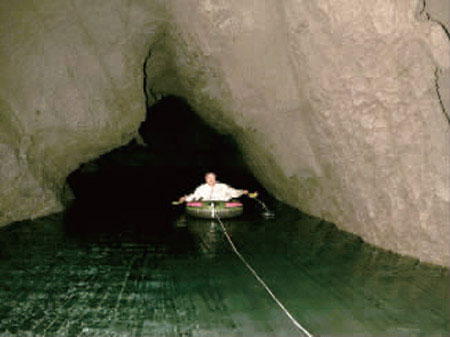Hidden river discovered in karst cave in Beijing
Updated: 2007-12-04 09:23
Explorers in rural Beijing's Fangshan District have recently discovered a hidden river inside a famous karst cave, prompting them to form a bigger team to explore the origin of the river and scout out other treasures tucked away in the deeper reaches.
The Shihua (Stone-flower) Cave is located at Nancheying Village in Hebei (note: same name as with the Chinese Province) Township 50 kilometers southwest of central Beijing. The first four floors of the multi-layer limestone structure have been opened to tourists.
The Beijing Times newspaper reports that geologists made a preliminary exploration of the largely untapped areas from the fifth floors downward this summer. A subterranean river was spotted at the seventh floor running intermittently for about 100 meters long.
Chen Haijian, an official with the management committee of the cave, describes the river as about two-meter deep flowing west-eastward with no sound. The water is crystal clear and freezing cold.
Chen rowed a rubber raft for about 30 meters on the river, disembarked and forced his way into a rocky cave. He walked for 100 meters and thought he had reached the bottom of the cave when he noticed an opening in which, to his great astonishment, he found yet another river.
Chen recalled that at that time he felt he had hit upon the gate that would lead to the utopian land as described in classic Chinese work "The Tale of the Peach Blossom Spring". The subterranean river in Shihua Cave might be linked with the river in another karst cave, the Silver Fox Cave, less than 6 kilometers away, making the two caves inter-connected, Professor Lin Junshu with the Institute of Geographical Sciences and Natural Resources Research (IGSNRR) of the Chinese Academy of Sciences (CAS), made a bold speculation on the source and flowing direction of the river. About a dozen karst caves are located within a 10-kilometer radius of the Shihua Cave.
Chen said the Shihua Cave management authority plans to form an exploration team to draw a detailed map from the fifth to seventh floors. Chen notes, however, the exploration will be for the purpose of research only and the untapped sections of the cave will never be open to tourists in order to preserve the natural state and integrity of the structures. The Shihua Cave was discovered back in 1446 by a monk in the Ming Dynasty. The cave, which opened to visitors in 1987, has an interior temperature of 13 degrees. The stalactites in the cave are labeled as "Millennium thermometers" as they help to give clues to the change in summer temperature in Beijing from 665 BC to 1985.
|
|
|
||
|
||
|
|
|
|


